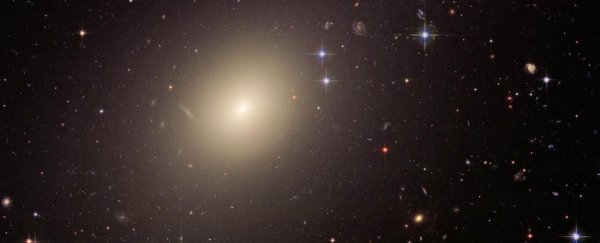The Milky Way galaxy isn't very active, as far as galaxies go. Every year, it produces around three to four Suns' worth of new stars in the entirety of its spiral body, and stars of all ages can be found sprinkled throughout.
But there are some galaxies even quieter – elliptical galaxies, for which most star formation ceased long ago. In these galaxies, none or very few stars can be found younger than a certain age, suggesting that at some point most star formation abruptly ceased, leaving the galaxy to slowly wink out over the eons, star by star.
Exactly how star formation is switched off in these smooth, nearly featureless galaxies is something of a mystery, but astronomers believe it has something to do with the supermassive black holes found at the center of every galaxy. Now an international team of astronomers led by Kei Ito of the Graduate University for Advanced Studies, SOKENDAI in Japan has peered back into the early Universe to find out if that's the case.
Using some of the world's most powerful telescopes, they have collected data in multiple wavelengths of light to identify galaxies whose light has traveled 9.5 billion to 12.5 billion years across the gulf of space-time – ancient galaxies like those elliptical galaxies closer to us in space and time, for whom star formation is on the brink of being snuffed out.
The first step was to use optical and infrared data to identify galaxies for which star formation is ongoing, and those in which star formation has ceased.
The next step was to use X-ray and radio data to identify supermassive black hole activity. This is the mechanism by which astronomers believe star formation may be quenched. When a supermassive black hole is active, it devours vast amounts of matter from the space around it. This process is a messy, violent one, producing what is collectively known as "feedback".
We all know nothing can emerge from beyond the event horizon of a black hole, but the space around it is a different matter. Material swirls around the black hole, like water circling a drain; the gravity and friction generate intense radiation that blazes across the Universe.
Another form of feedback takes the form of jets blasting from the black hole's polar regions. Material outside the event horizon is thought to be accelerated along the black hole's exterior magnetic field, to be launched from the poles as powerful, focused jets of plasma that travel at a significant percentage of the speed of light.
Finally, active supermassive black holes generate intense winds that sweep out into their galaxies. All three forms of feedback – the radiation, the jets and the winds – are thought to heat and push away the cold molecular gas that is required for the formation of baby stars.
Across such vast distances, galaxies are much harder to see; they are very small and very faint, from our point of view in the here and now. So the researchers had to 'stack' the galaxies together in order to emphasize the radio and X-ray light that are the telltale signs of an active supermassive black hole all those billions of years ago.
But it worked; the team found an "excess" X-ray and radio signal too strong to be explained by the stars alone in the galaxies with little to no star formation. The best explanation for this signal is an active supermassive black hole. Moreover, the signal wasn't as pronounced in the galaxies with ongoing star formation.
This suggests, the researchers concluded, that it's very plausible an active supermassive black hole plays a role in the abrupt deaths of these mysterious, ghostly galaxies.
Future research, they said, may help shed light on the detailed physics of this mysterious process.
The research has been published in The Astrophysical Journal.
Cover image credit: NASA, ESA, and The Hubble Heritage Team/STScI/AURA; J. Blakeslee /Washington State University.
